| Author |
Message |
Rodolfo Martínez

|
 Posted: Tue 16 Jan, 2007 4:44 pm Post subject: Hospitaller´s armour Posted: Tue 16 Jan, 2007 4:44 pm Post subject: Hospitaller´s armour |
 |
|
Hello gentlemen.
I was browsing the web searching for any help or description about Malta knights´ armour, and i found this article:
http://www.myArmoury.com/feature_armies_orders.html
But that was the only info wich i could get from the web. There aren´t much sites, info or photos refered to the topic, and the armours shown are always ¨naked¨, without any at least reproduced cloth ornament of the original suit, so. my question is How the Malta Knight´s armour was, or if it had any especial distinction like a cloth skirt or how their supravest was and inserted in the armour considering a knight wearing a XVI full harness?
Thanks to all.
¨Sólo me desenvainarás por honor y nunca me envainarás sin gloria¨
|
|
  |
 |
|
Lafayette C Curtis
|
 Posted: Wed 17 Jan, 2007 6:47 am Post subject: Posted: Wed 17 Jan, 2007 6:47 am Post subject: |
 |
|
Why not check the Order's own website? It's here:
http://www.orderofmalta.org/
And this image of a reenactment group may give some idea of the reconstructed garb of the Hospitaler forces, though obviously not all of them are knights of the Order:
http://en.wikipedia.org/wiki/Image:Malta_Knights.jpg
I wish I could find out the name and/or website of the reenactment group, but since the Hospitalers are not within my main area of interest you might have better luck with the job. 
|
|
  |
 |
Richard Fay

|
 Posted: Wed 17 Jan, 2007 12:06 pm Post subject: Posted: Wed 17 Jan, 2007 12:06 pm Post subject: |
 |
|
Hello all!
Rodolfo,
You might find more about the Knights Hospitaller if you search for the Knights of St. John, another name (actually, a part of their full name) that they are known by.
The Knight's Hospitaller might wear a heraldic tabard with the order's charge over their armour. Alternately, they might have worn armour with the charge engraved directly upon the breastplate.
There is a photo of armour worn by Vicenzo Capponi (1545-70) in the Osprey book The Knights of Christ by Terence Wise. Capponi fought in the siege of Malta in 1565. His breastplate has a small version of the order's cross engraved on the upper portion.
Another photo from the same source shows the effigy of Don Juan de Vergara, Proctor of the Langue of Castile, from 1575. He has a large eight-pointed star carved in relief on his breastplate. This was the style of cross preferred in the order in the mid 15th to the 16th centuries.
Yet another photo from the same source shows two 16th-century breastplates that bear the cross of the order. In each case the cross is engraved to appear almost as a pendant hanging from cords.
There are other period images of the Knights of St. John in the same source. Many others show the knights wearing heraldic tabards or jupons bearing the cross of the order.
A painting of the Knights Hospitaller preparing to defend Rhodes shows them in heraldic tabards over their armour. It also shows them wearing long hand-and-a-half or bastard swords at their sides. This could answer your question in the other thread about swords; they may certainly have used bastard swords, so it wouldn't be a stretch to see an occasional Knight of St. John wielding a two-handed sword in the same period.
I found one image of a Knight of Rhodes in late 15th century armour with a heraldic tabard displaying the Hospitaller's white cross on a red ground. It's from a fresco by Pinturichhio in Siena Cathedral. Sorry for the poor quality of the image; the original on the web site where I found this was of poor quality.
I hope this helped!
 Attachment: 40.15 KB Attachment: 40.15 KB
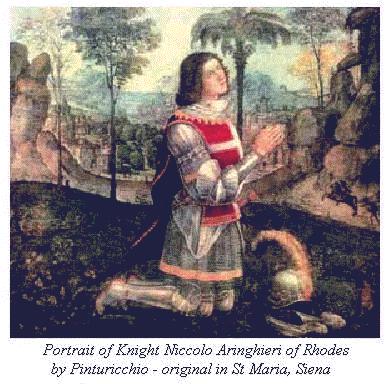
Fresco of Knight of Rhodes.
"I'm going to do what the warriors of old did! I'm going to recite poetry!"
Prince Andrew of Armar
|
|
 |
 |
Richard Fay

|
 Posted: Wed 17 Jan, 2007 12:33 pm Post subject: Posted: Wed 17 Jan, 2007 12:33 pm Post subject: |
 |
|
Hello again!
I found a couple more images of Knights Hospitaller during the time of the siege of Rhodes. The first is the one I mentioned before, depicting the Knights Hospitaller preparing to defend Rhodes. Note the hand-and-a-half swords as well as the heraldic tabards. The other depicts the actual siege of Rhodes. Here's the information for the second image:
Source: Caoursin, Guillaume, Siege of Rhodes, Rhodes 1482-1498.
Copy in the Bibliothèque Nationale, Paris, MS Lat. 6067.
Sorry again for the poor quality of the second image; the image on the site I found this was already of poor quality.
 Attachment: 46.91 KB Attachment: 46.91 KB
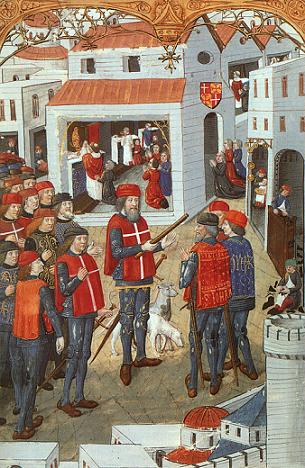
Knights Hospitaller preparing to defend Rhodes.
 Attachment: 53.45 KB Attachment: 53.45 KB
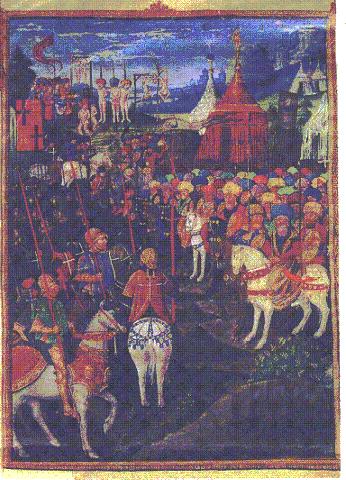
Siege of Rhodes.
"I'm going to do what the warriors of old did! I'm going to recite poetry!"
Prince Andrew of Armar
|
|
 |
 |
Richard Fay

|
 Posted: Wed 17 Jan, 2007 12:54 pm Post subject: Posted: Wed 17 Jan, 2007 12:54 pm Post subject: |
 |
|
Hello again!
I've found an image from the National Maritime Museum in London that shows the siege of Malta. It's not overly clear or detailed, but there is at least one good example of the sort of garment the Knights of Malta wore over their armour at that time.
Here's the information regarding the image:
The Siege of Malta: Assault on the Post of the Castilian Knights, 21 August 1565.
 Attachment: 46.27 KB Attachment: 46.27 KB
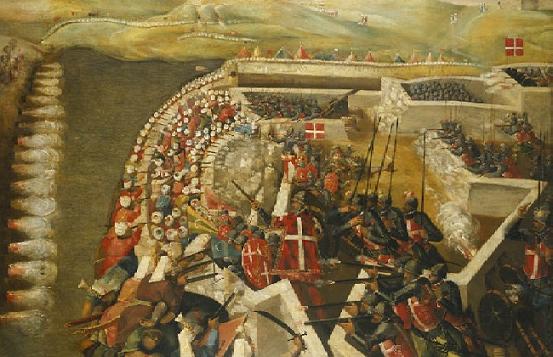
© NMM London
"I'm going to do what the warriors of old did! I'm going to recite poetry!"
Prince Andrew of Armar
|
|
 |
 |
Rodolfo Martínez

|
 Posted: Wed 17 Jan, 2007 6:43 pm Post subject: Posted: Wed 17 Jan, 2007 6:43 pm Post subject: |
 |
|
Thanks for the info Mr. Fay.
This morning i´ve found the following Malta armour photo, and, as i´ve seen in a T.V. program years ago all armours have a similar pauldron pattern(Even full armours), so my doubt is how a tabard is inserted in the armour considering the movement restriction that pauldrons could give to the guy, and if tabards were used above or under the big pauldrons, and if it was an ornament obligatory to wear ?
Thanks
 Attachment: 87.53 KB Attachment: 87.53 KB
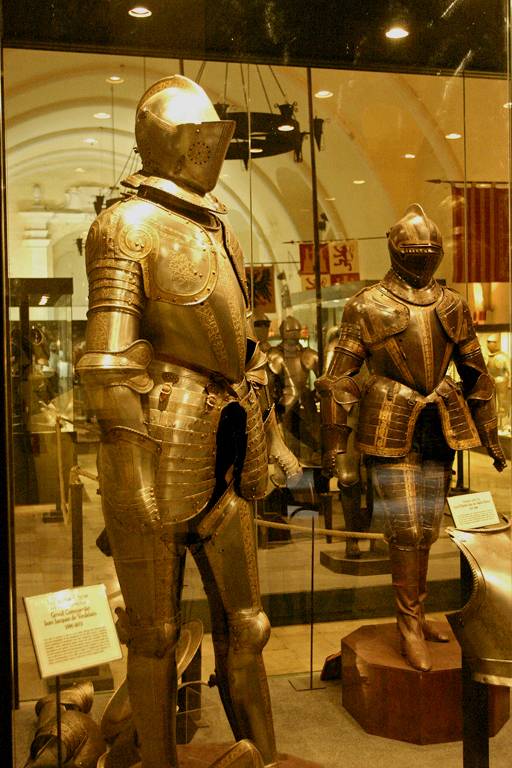
Take a look to this armour with it´s two huge pauldrons, was posible to fit on tham a tabard without bothering the pauldrons movemen?
¨Sólo me desenvainarás por honor y nunca me envainarás sin gloria¨
|
|
  |
 |
Richard Fay

|
 Posted: Wed 17 Jan, 2007 7:25 pm Post subject: Posted: Wed 17 Jan, 2007 7:25 pm Post subject: |
 |
|
Hello all!
Rodolfo,
The tabard would be a relatively loose garment, so it might not interfere too much with the armour. However, it is just as possible that it was discarded with armour like you showed; there are Hospitaller breastplates that have their cross engraved right onto the plate.
I'll see what else I can dig up later.
Stay safe!
"I'm going to do what the warriors of old did! I'm going to recite poetry!"
Prince Andrew of Armar
|
|
 |
 |
Richard Fay

|
 Posted: Wed 17 Jan, 2007 7:37 pm Post subject: Posted: Wed 17 Jan, 2007 7:37 pm Post subject: |
 |
|
Hello again!
I did find this small image on the official site of the Sovereign Order of the Knights of Malta. It's a pretty good depiction of the sort of garment worn over armour during the siege of Malta in the 1500's. Note the short sleeves and the general cut of the garment.
 Attachment: 6.02 KB Attachment: 6.02 KB
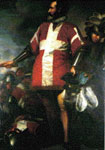
Knight of Malta
"I'm going to do what the warriors of old did! I'm going to recite poetry!"
Prince Andrew of Armar
|
|
 |
 |
|
Marco Signore
|
 Posted: Thu 18 Jan, 2007 4:24 am Post subject: Posted: Thu 18 Jan, 2007 4:24 am Post subject: |
 |
|
The Knights of Malta were no longer "hospitallers", so if you look for the "hospitaller" armour you will find most possibly a hauberk of mail. However, as the Knights of S. John, or Knights of Malta were a Knightly Order, most possibly they used the best equipment available at their time. There is at least one portrait of a noble belonging to the order in the works of the Italian portrait painter Tiziano, and further similar paintings are to be found with relative ease.
For what concerns the tabard I don't think they used it so much during the second half of the XVI century, as the "white armour", that is the use of wearing armour without tabard, should start around the first half of the XVI century.
I have seen a Knight of Malta armour, and it bears the cross of the order directely carved on the breastplate, and this MAY mean that the harness was intended to be used without a tabard.
|
|
  |
 |
|
Lafayette C Curtis
|
 Posted: Thu 18 Jan, 2007 5:08 am Post subject: Posted: Thu 18 Jan, 2007 5:08 am Post subject: |
 |
|
Well, Rodolfo, if we look closer at the pictures it would be obvious that the supravests were worn entirely outside the armor, not tucked in or inserted. The armors in the museum photograph would also have been quite atypical for the knights in Rhodes or Malta, as Richard has mentioned in the other thread. Most of the armors--even for the brother knights--would have been plainer and the owners would perhaps have been more eager to decorate them wih external fabric coverings.
Still, I agree with the others in that the supravests would not have been universal. Just about everybody have mentioned that the ornate armors--especially with the crosses etched/carved/embossed directly upon the cuirass--might have been worn without tabards or surcoats or supravests. And it is even more probable that both covered and allwhite varieties of armor would have been seen in the same battle--after all, it would be too much to suppose that the equipment of all the Rhodian/Maltese force was entirely uniform. Even the brother knights wouldn't have been totally uniform, let alone the mercenaries and non-ordained foreign volunteers.
|
|
  |
 |
Rodolfo Martínez

|
 Posted: Thu 18 Jan, 2007 7:25 am Post subject: Posted: Thu 18 Jan, 2007 7:25 am Post subject: |
 |
|
Yes bros, not all ¨knights¨ used full armours, but what i´m not sure if the armour that i have shown before was a battle one, Was it an ornamental one?
And about their weaponry, i know little more than nothing about rapiers, but, wasn´t more effective a longsword to face the light armored Turks?
I´m not saying that rapiers aren´t good weapons, they have an amazing reach, but as far as i know most of them were most used as duel weapons.
Thanks
¨Sólo me desenvainarás por honor y nunca me envainarás sin gloria¨
|
|
  |
 |
Richard Fay

|
 Posted: Thu 18 Jan, 2007 8:04 am Post subject: Posted: Thu 18 Jan, 2007 8:04 am Post subject: |
 |
|
| Rodolfo Martínez wrote: | Yes bros, not all ¨knights¨ used full armours, but what i´m not sure if the armour that i have shown before was a battle one, Was it an ornamental one?
And about their weaponry, i know little more than nothing about rapiers, but, wasn´t more effective a longsword to face the light armored Turks?
I´m not saying that rapiers aren´t good weapons, they have an amazing reach, but as far as i know most of them were most used as duel weapons.
Thanks |
Rodolfo,
I think you could say that the armours you showed are "lordly" armours - armours for great nobles. It just as Nicolle mentions in the Osprey book about the Knights Hospitaller - the richly decorated armours in the museums were the ones for the great noblemen, while the knights of the Order (did they really drop the title "Hospitaller" from their official name by the time they reached Malta? - my sources aren't clear on that point) might wear armour of more a "munitions" grade. Certainly some of the higher officials in the Order would have worn decorated armour, like the breastplates engraved with the Order's cross that I mentioned earlier, but the majority were probably armed in a less lavish harness.
If they wore rapiers as Seward suggests, I would think they would have been more of a secondary sidearm. Again, Nicolle pointed out in his Osprey book about the Knights Hospitaller that the Order was very willing to adopt firearms. Also, many would have used some sort of pole arm.
I'm sure there is a lot of information regarding rapiers here on myArmoury - do a search and see what you can find.
Here's an example, an article about the Italian rapier:
http://www.myArmoury.com/feature_arms_rapier.html
I hope this helped!
Stay safe!
"I'm going to do what the warriors of old did! I'm going to recite poetry!"
Prince Andrew of Armar
|
|
 |
 |
|
Marco Signore
|
 Posted: Thu 18 Jan, 2007 10:42 am Post subject: Posted: Thu 18 Jan, 2007 10:42 am Post subject: |
 |
|
| Rodolfo Martínez wrote: | Yes bros, not all ¨knights¨ used full armours, but what i´m not sure if the armour that i have shown before was a battle one, Was it an ornamental one?
And about their weaponry, i know little more than nothing about rapiers, but, wasn´t more effective a longsword to face the light armored Turks?
I´m not saying that rapiers aren´t good weapons, they have an amazing reach, but as far as i know most of them were most used as duel weapons.
Thanks |
About the weapons: I've used several times a replica of one of the swords used by the Knights in the siege of Malta. It is called "granchio pisano" (translated vaguely as "crab from Pisa"). Very strong and quite heavy one handed sword with a curved guard, almost a series of talons to trap and break enemy baldes, and an additional protection for the fingers in the anterior part of the hilt as well. As soon as I find a picture I will try to post it here.
OT: my reenactment group is totally devoted to knights hospitaller, but unfortunately from the XIII century.
|
|
  |
 |
|
Lafayette C Curtis
|
 Posted: Thu 18 Jan, 2007 11:38 am Post subject: Posted: Thu 18 Jan, 2007 11:38 am Post subject: |
 |
|
|
And obviously, weapon comparisons that may be valid in one-on-one fighting may no longer work so well in massed fighting. In a massed battlefield I'd rather have more friends on my side than the "right" kind of weapon, regardless of what that weapon was!
|
|
  |
 |
Rodolfo Martínez

|
 Posted: Thu 18 Jan, 2007 3:26 pm Post subject: Posted: Thu 18 Jan, 2007 3:26 pm Post subject: |
 |
|
| Quote: | | And obviously, weapon comparisons that may be valid in one-on-one fighting may no longer work so well in massed fighting. In a massed battlefield I'd rather have more friends on my side than the "right" kind of weapon, regardless of what that weapon was! |
Yes, like in the siege of Malta, There are thousand of angry Turks there, but i don´t worry . Mmm, let me see.. how many friends i have? Two?, Three?, one of them lying there with a bullet in his head  . .
No, seriously, it´s true that in a massed fighting you have friends, but it´s a matter of the right friend too. I don´t know what type of armour Turks used, but i think that a rapier, without understimating the powerful superior thruster, is not as powerful and versatile as a longsword, i would prefer tucks for trusters.
¨Sólo me desenvainarás por honor y nunca me envainarás sin gloria¨
|
|
  |
 |
Richard Fay

|
 Posted: Thu 18 Jan, 2007 3:45 pm Post subject: Posted: Thu 18 Jan, 2007 3:45 pm Post subject: |
 |
|
| Marco Signore wrote: | | The Knights of Malta were no longer "hospitallers", so if you look for the "hospitaller" armour you will find most possibly a hauberk of mail. However, as the Knights of S. John, or Knights of Malta were a Knightly Order, most possibly they used the best equipment available at their time. |
Marco,
The Knights of St. John never fully abandoned their "hospitaller" function - they always ran hospitals alongside their military activities. In fact, they are still involved in this sort of work today.
Here's a few mentions of various hospitals of the order, taken from The Knights of Malta by H. J. A. Sire:
| H. J. A. Sire wrote: |
Whatever the uncertainties about the Order's future as it gathered its sad remnants in Cyprus, its primitive duty was still imperative, and a new Hospital was founded at Limisso in 1296. It had no opportunity for great development and has left no architectural trace. In Rhodes a Hospital was soon founded after the conquest, a building with spacious halls at the bottom of the Street of Knights, located near the harbour so that the wounded or sick could be tranferred to it quickly. It was a much more modest building than the hospital of Acre, let alone that of Jerusalem, but it evidently sufficed for the members who dwelt and passed through Rhodes at the time. The Order's medical specialisation was taken a step further at Rhodes, for there was no pilgrims' hospice at all, and when Dominique d'Alemagne founded the hospice of St, Catherine at the end of the fourteenth century it was to provide lodging for rich visitors to the city. "Our Lords the Sick" had definitely replaced "Our Lords the Poor" as objects of the Order's charity. The change only made the brethren's care of the sick all the more lavish, and in the fifteenth century the Grand Master Fluvia ordered the construction of what was to be the most beautiful of all the Order's hospitals, and one of the finest of medieval Europe...
The rules of the Hospital in the fifteenth century required the doctors to visit the sick at least twice a day and to write down their opinion...
When the knights arrived in Malta they found a small population whose needs were already served by a hospital in Notabile. For the first time, therefore, the hospital which they built in 1533 in the Borgo made no provision for women (a separate women's Hospital was founded in the early seventeenth century), it was evidently intended not for the local population but for sailors and soldiers, a service which Malta's character as a crossroads of the Mediterranean made particular useful. After the move to Valletta the new Hospital was not built until 1575, so that for three years the knights had to cross the Grand Harbour to perform their duties. The Infermeria was built next to the harbour's edge, as those of Rhodes had been, though this position had the double disadvantage of being less central and exposed to the African sirocco.
Like other buildings of Valletta, the Hospital was very much more functional than that of Rhodes. It consisted of a single long ward, to which others were added later...
The regulations of the seventeenth century laid down that three doctors including a surgeon must sleep in the Hospital every night...
Service in the Hospital was obligatory for the novices once a week, and each Langue had a day of the week appointed for that attendance...
In the eighteenth century efforts were made to strengthen the scientific basis of the Order's medical work in Malta...
Service in the Hospital was an integral part of the twelve months' noviate undergone by all the knights...
Fra Angelo De Mojana was Grand Master for twenty-six years, and under the governoing of this unassuming and affable prince of the Order of Malta experienced a growth which has made it one of the largest associations of the Catholic Church and one of the most active hospitaller organisations in the world. The number of knights has increased from 3,000 to over 10,000 and that of National Associations from 28 to 39.
The Order's work as a religious and Hospitaller body is manifested first by its various pilgrimages for the sick and disabled. The most important of these is the pilgrimage to Lourdes, held in the first week of May, an event which was initiated in 1950 and now regularly brings together 3,000 members of the Order with many hundreds of patients... |
So, apparently the Knights of Malta did continue as Hospitallers, at least in terms of the work they did (and still do).
I hope someone found this of interest!
Stay safe!
"I'm going to do what the warriors of old did! I'm going to recite poetry!"
Prince Andrew of Armar
|
|
 |
 |
Richard Fay

|
 Posted: Thu 18 Jan, 2007 4:36 pm Post subject: Posted: Thu 18 Jan, 2007 4:36 pm Post subject: |
 |
|
| Rodolfo Martínez wrote: |
No, seriously, it´s true that in a massed fighting you have friends, but it´s a matter of the right friend too. I don´t know what type of armour Turks used, but i think that a rapier, without understimating the powerful superior thruster, is not as powerful and versatile as a longsword, i would prefer tucks for trusters. |
Rodolfo,
I found a brief mention, apparently from a period eyewitness, of the appearance of the Turkish army during the Siege of Malta of 1565. Here's the biref excerpt from Desmond Seward's The Monks of War:
| Desmond Seward wrote: |
Of the enemy troops, Turkish, Algerian and Corsair, Balbi, an eywitness, wrote: "Even the rank and file wore scarlet robes and there were many in cloth-of-gold and of silver and of crimson damask. Armed with fine muskets of Fez, scimitars of Alexandria and Damascus, they all wore splendid turbans." |
This is what it says about Ottoman Janissaries in Fact Finder Guide: Warriors by Ian Westwell and Nick Grant:
| Ian Westwell and Nick Grant wrote: |
The Janissaries were originally equipped with bows, crossbows, and javelins, but these were superseded by early muskets in the 16th century. They were renowned for their colorful, flamboyant uniforms, which consisted of a short-sleeved, flowing, ankle-length coat over a long-sleeved tunic. The coat was often turned up at the front and tucked into a sash or held in place with buttons. On parade, a tall, usually white, felt hat with plumes was worn. |
I hope this helped! Others here may be able to add more details.
Stay safe!
"I'm going to do what the warriors of old did! I'm going to recite poetry!"
Prince Andrew of Armar
|
|
 |
 |
Steve Grisetti

|
 Posted: Thu 18 Jan, 2007 5:05 pm Post subject: Posted: Thu 18 Jan, 2007 5:05 pm Post subject: |
 |
|
| Richard Fay wrote: | | Rodolfo Martínez wrote: | ... And about their weaponry, i know little more than nothing about rapiers, but, wasn´t more effective a longsword to face the light armored Turks?
I´m not saying that rapiers aren´t good weapons, they have an amazing reach, but as far as i know most of them were most used as duel weapons .... |
... If they wore rapiers as Seward suggests, I would think they would have been more of a secondary sidearm .... |
When one speaks of a rapier, I tend to think of the stereotypical "thrust-oriented" rapier, like the Arms & Armor German Rapier, which replicates a weapon created around 1600:

This sort of sword is really more of a civilian, duelling weapon. Knights or soldiers of the time would have tended to use a heavier sword, such as this Arms & Armor Dresden Rapier, which replicates a weapon created around 1590:

This sword would be much more effective in a military combat situation that the typical rapier.
| Arms & Armor wrote: | | The blade is wider at the hilt than most rapiers and is, in fact, what many people would consider a broadsword blade. These extremely heavy rapiers were often used as calvary side arms. |
Obviously, the type of sword that the Knights of Malta/Hospitallers would have used is very dependent on the time frame. If you are thinking of the weapons that would have been used during the 1565 Siege of Malta, that is just a tad early for either of the examples mentioned above, as you can tell by the dates. I hope this is helpful.
"...dismount thy tuck, be yare in thy preparation, for thy assailant is quick, skilful, and deadly."
- Sir Toby Belch
|
|
  |
 |
|
Marco Signore
|
 Posted: Fri 19 Jan, 2007 2:17 am Post subject: Posted: Fri 19 Jan, 2007 2:17 am Post subject: |
 |
|
While Knights of Malta retained several Hospitals on the Island, and even carried on some kind of medical research, they were no longer namend "hospitallers". Their role remained pretty much true to their origins as a non-military, hospitaller order, but thename was changed (and I think they were still known as Kinghts of St. John, according to the historical fonts).
Aside from The Monks of War, there is another book that those of you interested in the Malta period of the Knights of St. John may find useful. It is from a French author and I only know the Italian and French title:
Prosper Jardin and Philippe Guyard, Les Chevaliers de Malte
Also I would suggest the excellent book by Helen Nicholson titled The Knights Hospitaller.
|
|
  |
 |
|
Lafayette C Curtis
|
 Posted: Fri 19 Jan, 2007 6:42 am Post subject: Posted: Fri 19 Jan, 2007 6:42 am Post subject: |
 |
|
Er...I don't think the "Hospital" was ever an official part of their name. They were the "Knights of St. John of Jerusalem" right from the start. The ones who had the "Hospital" in their official name were the Teutonics (!).
And I was going to say something about the definition of "rapier" as well but Steve has got there first. We have to remember that "rapier" as a narrow thrusting weapon was the definition more often used in France and England; in Germany a "rapier" was practically any complex-hilted one-handed sword and in Italy the term didn't exist at all. So we have to be careful with the deifinitions in the sources, even the primary sources--especially if the primary sources are translated ones.
|
|
  |
 |
|
|
You cannot post new topics in this forum
You cannot reply to topics in this forum
You cannot edit your posts in this forum
You cannot delete your posts in this forum
You cannot vote in polls in this forum
You cannot attach files in this forum
You can download files in this forum
|
All contents © Copyright 2003-2024 myArmoury.com — All rights reserved
Discussion forums powered by phpBB © The phpBB Group
Switch to the Basic Low-bandwidth Version of the forum
|

